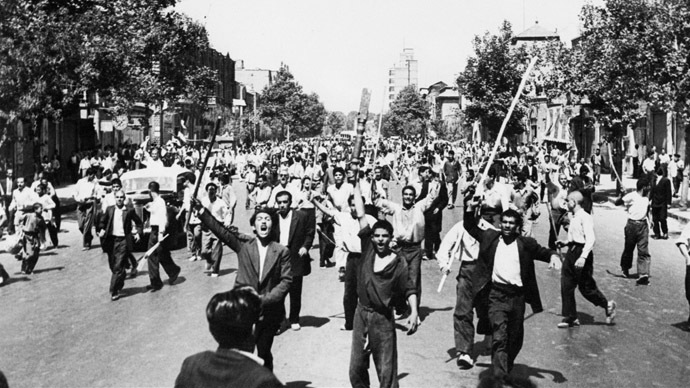CIA finally admits it masterminded Iran’s 1953 coup

On the 60th anniversary of the 1953 military coup in Iran that overthrew the government of radical nationalist Mohammad Mossadegh, the US has declassified documents detailing how the CIA’s secret operation brought the country’s Shah back to power.
“American and British involvement in Mossadegh’s ouster has long been public knowledge, but today’s posting includes what is believed to be the CIA’s first formal acknowledgement that the agency helped to plan and execute the coup,” the US National Security Archive said.
Monday’s publication under the US Freedom of Information Act came as something of a surprise, since most of the materials and records of the 1953 coup were believed to have been destroyed by the CIA, the Archive said. The CIA said at time that its “safes were too full.”
The newly-revealed documents declassify documents about CIA’s TPAJAX operation that sought regime change in Iran through the bribery of Iranian politicians, security and army high-ranking officials, and massive anti-Mossadegh propaganda that helped to instigate public revolt in 1953.
Among the declassified documents there are several examples of CIA propaganda presenting Iranian PM Mossadegh disparagingly.
“This propaganda piece accuses the Prime Minister of pretending to be ‘the savior of Iran’ and alleges that he has instead built up a vast spying apparatus which he has trained on virtually every sector of society, from the army to newspapers to political and religious leaders,” the Archive said. “Stirring up images of his purported alliance with ‘murderous Qashqai Khan’ and the Bolsheviks, the authors charge: ‘Is this the way you save Iran, Mossadegh? We know what you want to save. You want to save Mossadegh’s dictatorship in Iran!’”
In April 1951 Iranians democratically elected the head of the National Front party, Dr. Mohammad Mossadegh, as prime minister. Mossadegh moved quickly to nationalize the assets in Iran of the Anglo-Iranian Oil Company (the forerunner of today’s BP) a step that brought his government into confrontation with Britain and the US.
Britain’s MI6 military intelligence then teamed up with the CIA and planned, elaborated and carried out a coup that ousted Mossadegh in August 1953 and returned Shah Mohammad Reza Pahlavi to power.
The first attempted coup failed after Mossadegh got wind of the conspiracy, but American and British intelligence services in Iran then improvized a second stage of the coup, pulling pro-Shah forces together and organizing mass protests on August 19, 1953. These protests were immediately supported by army and police. Mossadegh’s house was destroyed after a prolonged assault by pro-coup forces, including several tanks.
Mossadegh was replaced with Iranian general Fazlollah Zahedi, who was handpicked by MI6 and the CIA. Mossaddegh was later sentenced to death, but the Shah never dared to carry out the sentence. Mossadegh died in his residence near Tehran in 1967.
The Shah’s pro-Western dictatorship continued for 27 years and ended with the Islamic Revolution of 1979, which paved the way for today’s Iran, where anti-American sentiments remain strong. The 1953 coup still casts a long shadow over Iranian-US relations.
The declassified documents originated from an interim report, called “The Battle for Iran,” prepared by a CIA in-house historian in the mid-1970s. The historian wrote: “[T]he military coup that overthrew Mossadegh and his National Front cabinet was carried out under CIA direction as an act of U.S. foreign policy.” The report also mentions that the US establishment feared that Iran could be “open to Soviet aggression,” and therefore initiated Operation TPAJAX, which eventually became the American part of the joint US-British ‘Operation Ajax’ that brought the Shah to power.
The “aggression” mentioned by the CIA historian is likely a reference to the Soviet Union’s intervention in Iran during WWII, when a USSR-Iran treaty signed in 1940 enabled Moscow to establish military prescriptive in Iran in case of any threat to the borders of the Soviet Union. Moscow did put this treaty to use during the WWII and partly occupied Iran in 1941-1945.
The National Security Archive said it that while it “applauds the CIA’s decision to make these materials available, today’s posting shows clearly that these materials could have been safely declassified many years ago without risk of damage to national security.”
Though at least two US Presidents, Bill Clinton and Barack Obama, have publicly acknowledged the US role in the Iranian coup, the intelligence services in Washington have always been reluctant to admit direct involvement in the 1953 coup.
After the collapse of the USSR, the CIA proclaimed a “policy of openness” and made a commitment to declassify some documents regarding Cold War covert operations, including the coup in Iran, by US intelligence.
Three successive CIA directors – Robert M. Gates, R. James Woolsey, and John M. Deutch – promised to publish documents, but none delivered.
Archive deputy director Malcolm Byrne appealed to the US intelligence community “to make fully available the remaining records on the coup period.”
“There is no longer good reason to keep secrets about such a critical episode in our recent past. The basic facts are widely known to every schoolchild in Iran. Suppressing the details only distorts history, and feeds into myth-making on all sides,”Byrne said.


1 opmerking:
De foto toont leden de pro-Sovjet partij Tudeh, waar Afshin Ellian lid van was. Die partij werkte aanvankelijk prima samen met Khomeini totdat die er achter kwam dat de gehele top van de Tudeh partij bestond uit Russische spionnen.
Een reactie posten